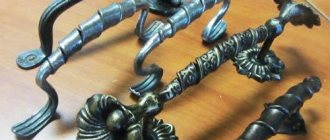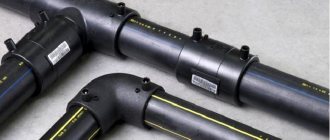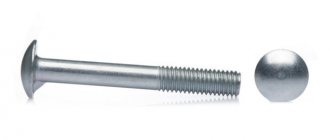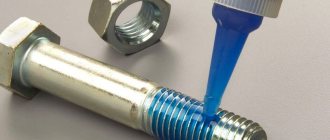Accessories
To properly equip the handle at the gate, it is important to first decide what type of handle it will be - whether a lock will be required, what type. The lock can be designed independently or a ready-made mechanism can be purchased. The main task is practicality. Before installation, pay attention to what material the gate itself is made of. Installation is carried out in accordance with its design. Locks as additional protection are presented in a wide range - padlocks, rack and pinion, sound, electromagnetic, mortise, etc.
Handle for gates and gates with your own hands
Types of locking fittings
When selecting a specific model, attention is paid to its type. This characteristic is one of the most important; it depends on the material, device and other qualities.
Depending on the type of locking hardware, the products are as follows:
- Overhead – include a bracket, a cone, and are supplemented with several holes at the base for fastening. For a gate made of corrugated sheets, it is better to take door handles of the C or G shape, which do not have holes and will need to be secured by welding. Craftsmen confirm the fact that welded parts last better and longer.
- Through - this type of different forms is available for sale. To secure it, holes are drilled in the door, and a threaded pin is inserted into the door and threaded into the handle. A second handle is attached to the reverse side. As a result, the same ones are located on both sides.
End-to-end model
- Rotary, push - it is recommended to use a handle-lock when installing the general structure. These types implement 2 tasks at once - reliable grip when opening, fixation thanks to the locking mechanism.
- Forged ones are the most popular of all due to their reliability and large selection of models. Products are often mounted on gates, even garage doors. They look as aesthetically pleasing as possible, blend harmoniously with the existing style, adding richness. Forged products become a real decoration.
The choice of suitable options is simply huge, everyone will choose what they like. In addition to the handle, a lock is also purchased.
Do-it-yourself latches and spring latches
DIY valve
To make the latch on the gate with your own hands reliable, you need to be guided by the structure of the factory design. However, the easiest way to make a valve is a vertical lock. It will require two pipes of different diameters.
Important! One pipe should move freely into the other.
You need to secure a large diameter pipe to the fence with self-tapping screws. The caps from the self-tapping screws on the street side are sawed off. You need to install a groove on the gate door that will hold the bar. After this, a self-tapping screw is drilled into the small pipe and the fixing bar is sent into the large-diameter pipe; the self-tapping screw will be held by the groove. After this, the deadbolt for the gate with your own hands is ready.
Mortise valves
The locking mechanism from the mortise valve is installed ready-made. The valve is inserted into the sockets made, but special loops can be made. This valve is installed simultaneously with the handle, so it will be convenient to use.
Don't miss: How to program gate remotes
There are also magnetic and radio-controlled models that will hold the gate until a signal is sent to the control panel.
Mechanism selection
A few decades ago, only a bolt and a latch for gates were installed. In the modern world, affordable and yet reliable models have been invented. They will not just decorate the gate and perform their function, simplifying opening/closing, but will reliably protect the territory from intruders.
Mechanical models for insertion are easy to install yourself and are classified into 3 main groups:
- Code ones. They are opened from the outside by entering numbers. To open from the inside there is a lever and a latch. The disadvantage of the mechanism is the abrasion of the buttons.
- Level ones. They differ in the shape of the keys. They have grooves with teeth of different heights, corresponding to thin plates inside the lock. If you use the wrong keys, you will not be able to open the lock. Suvald is essentially a hidden secret. The main advantage is long-term operation, the possibility of strengthening with a code, normal reaction to high humidity, and affordable cost. But there are also disadvantages. Primary – key too big. Also, many owners talk about the inconvenience of the fact that a key is also needed from the inside to open and close.
- Cylindrical. They differ in their needle-like mechanism. It should match the key perfectly. This type is also called English because it has a compact key. The mechanism can be repaired if necessary; it does not tolerate moisture or dust.
For gates, a rim lock with a handle is often purchased. Anyone can handle the installation of such a device.
Rules - how to choose
Owners of a private house select a lock for a gate taking into account its long service life, and before choosing, be sure to indicate the requirements for the product. Professionals advise keeping an eye on the following criteria during the purchasing process:
- Any lock should not be afraid of high humidity, dust, and must be fault-tolerant. Typically these are lever types of mechanisms with a beard key.
- It is better to choose options that will function properly from either side of the entrance and without a key. And when the mechanism is locked with a key from the outside - so that it can be unlocked manually from the inside.
- Compact locks and handles should be installed. For massive ones, strong gates of impressive size will be required. Large bolts do not harmonize well with the gate of their corrugated sheeting, and at the installation site the sheathing can easily be damaged.
- When purchasing, you need to check the ease of operation of the key. You should not take a model in which the key turns with force, as it will break faster.
- The installed mechanism must be rechecked several times. If inconveniences are identified, they are corrected immediately. The lock with the handle must be tightly attached to the blade, otherwise moisture accumulates in the gap after rain, ultimately rendering the product unusable.
- It is necessary to select models for outdoor use. With the right selection, the lock and handle for the gate will last as long as possible.
Once the selection is made, installation can begin. Any person with minimal experience can cope with this.
Video description
An idea for making a deadbolt yourself is shown in this video:
Using a similar technique, you can make a latch in the form of a barrier. The bar must consist of two halves so that the security latch provides double protection for the gate.
Sliding gates: bolts and latches
If sliding gates are installed on the site, then you need to know how to make a latch for the gate with your own hands. The advantage of such gates is that they are perfectly compatible with other types of locks. For example, a locking bolt is a very effective design that prevents the gate from opening from the outside. For production you will need old spare parts from a domestic car. But even if they are not there, you can use available parts.
Self-production
Before you can construct a simple model yourself, you will need to prepare a set of tools. If the product is planned to be made of wood, then you need a carpentry tool set, and for a metal product you will need a welding machine.
Below is an algorithm for creating an ordinary fixed handle yourself:
- Decide on the size of the product. To make it convenient to use the handle, the working part should be made in length equal to two fists of an adult, and the distance to the canvas should be at least one fist.
- Selection of workpiece. Suitable steel fittings with a diameter of at least 10 mm, timber or part of a pipe.
- Carrying out markings. The length of the workpiece consists of the working part, the thrust part and the fastening area.
- Using a hammer, a vice and a pipe with a diameter larger than the workpiece, you need to progressively make bends until the part takes the desired shape. Wood products are cut from thick boards or timber, shaping the surface for ease of grip.
- At least two holes must be made on the site for fastening.
- The handle is attached using self-tapping screws and then welded.
- Installation is completed by cleaning and applying paint.
After completion and proper implementation of the work, the gate looks beautiful. With effort, a self-made pen looks no worse than store-bought ones.
Choosing a pen
Handles for gates and gates are presented in two types on the country's construction market. The former are fixed statically, while the latter are rotary with a locking mechanism.
The photo shows a forged handle.
Overhead handles are easier to install
According to the installation method they are classified into:
- Invoices. Such handles are rigidly attached to the sash leaf with self-tapping screws or welding. On the reverse side, install a similar handle in the same way.
- Through. The design provides for a prefabricated double-sided handle. For installation, a hole of the required diameter is drilled in the canvas and fixing rings are installed. The locking mechanism is represented by the second end of the movable part of the handle with a hook on the outer support column.
- Mortise, where the handle is a structural element of a factory locking device. Mounted in hollow doors. Narrow frame profiles limit installation.
One of the types of mortise handle for gates
Regardless of the choice of handle type, shape and appearance, the handle must meet the standards for safe use, as well as be practical for everyday use.
For the gate
Entrance gates are complemented with handles of any configuration and design. It is important that it harmoniously combines with the appearance of the entrance to the courtyard, while efficiently performing its direct function. A number of photographs presented in the article demonstrate this.
The entrance handle should match the exterior of the entire fence
Trademarks that are manufacturers of gates and wickets produce high-quality fittings. In the segment of matching price and quality, door handles for Dorhan gates are popular.
The simplest designs of movable gate opening devices are divided into:
- a knob system, where a handle with a latch acts on the lock by turning the knob (knob), while individual handles are equipped with a mini-lock with a pin. Such a system requires periodic maintenance;
- halyard system, activated by pressing the shoulder of the handle. It does not perform a protective role, but simply fixes the closed position of the sash with a rotating mechanism.
Rim lock with visor
The best option is an overhead (built-in) lock with a beautiful handle for the gate. Installed on the sash, it solves several problems simultaneously, including limiting unauthorized entry into the territory. Maintenance of such a lock is simple, and if it fails, it can be quickly replaced with a similar model from Bravo, AGB, Doorhan, ViRO.
For gates
The design features of the gate determine the type of handle and its location:
- Standard swing gates. Typically, a removable deadbolt, as well as sliding lower or upper locks, are used to lock the sashes. In such gates, owners rarely install handles, using limiters as them. Additionally, padlock shackles are welded on the inside of the gate profile itself.
- Swing gates with electric unlocking devices. Such gates are opened manually only in the absence of electrical power. Handles are installed from the inside. They should be comfortable and look harmonious on the door leaf.
- Sliding sectional doors. They are equipped with automatic opening systems and opening handles in emergency situations, and there are also mechanical ones. One of the options for such gates is represented by a collection of stainless steel handles framed in plastic, which are a bestseller of the Doorhan brand.
The photo shows a gate at the dacha.
The handle on the gate should fit harmoniously into the structure
The installation of additional locking devices is only justified at gates that are opened manually. In other cases, they are an unnecessary element, since automatic systems in the off position block the tearing off (shifting) of the sashes quite reliably.
Sliding sectional design with automation
Installing an overhead option for closing the gate
One of the best and optimal options is a rim lock with a beautiful handle. It is placed on the sash, thereby solving several important problems:
- limiting entry into the perimeter of the property;
- ease of maintenance;
- quick replacement in case of breakdown.
Rim locks are mounted using fasteners for which holes are made in advance. The latch is placed on the reverse side of the gate. It is convenient to use due to its ease of operation and reliability.
Simplify installation easily. A transverse beam is fixed to the door frame by welding at a distance of about 90 cm from the ground. The lock is applied to the frame from the inside so that the hole for the fastening coincides with the beam, the handle with the core is located slightly higher or even lower, depending on the convenience of the owners. Now make the markings, remembering the crossbar and fastenings.
Overhead
When the door supports are made from a round pipe, first a plate is attached to it, where the counter part is fixed. Then you need to drill holes for fasteners, a handle, and a key with a drill. They are made along the contours and passed with a file to remove the husks. A groove for the crossbar is also formed. Only then is the lock with the core, handle, and linings on both sides mounted.
Video description
If you don’t know what a retainer looks like, watch this video:
The operating procedure is as follows:
The vertical lock is a pipe with reinforcement for a lever. The tube is fixed to the door or frame. Another tube is attached to the reinforcement, but of a smaller diameter. A small piece will keep the gate from opening. So two metal tubes with reinforcement are just a way to make a deadbolt for a gate made of corrugated sheets.
Another option that you can make yourself is a grooved bolt, reinforced with a rotary device. Its mechanism is similar to a pinwheel, but this design has additional parts. First, a rotating mechanism is attached to the fence on one of the leaves. A mechanical lock is attached to the second sash or to the frame from the second sash. If you want more reliability, you can use automatic locks. A groove is attached to the rotary bolt, which is connected to the latch when the gate is closed.
Source
Installation of the mortise mechanism
The steps for attaching the handle to a mortise lock are as follows:
- A place for the handle is marked on the sash.
- At the marked points, holes are formed for screwing in self-tapping screws; the notches must be ground.
- The handle is attached to the gate with self-tapping screws.
- A rectangular groove is formed for the lock, and the lock body is mounted there. The loose product is outlined to identify points for fastening.
- If a handle is included in the package, a hole is drilled for it, then during installation the handle is attached to the rod.
- When the holes for the fasteners are finally ready, the lock is securely fixed using self-tapping screws.
Mortise
Installation features
The standard handle installation procedure includes:
- markings on the gate canvas;
- preparatory work (drilling holes);
- product fastening.
Installing a mortise lock with handle
To install a locking mechanism of this type, you must:
- mark the location of the lock on the canvas and cut out a rectangular groove in this place;
- check whether the structure fits into the hole;
- drill an outlet for the connecting rod into which the push lever will be inserted;
- fix the product, additional elements.
The variety of handles for street gates allows you to choose the appropriate option for the entrance structure, which will meet the necessary criteria of protection, safety, reliability, and aesthetics.











